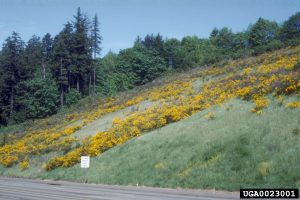California Invasive Species Action Week
When insects, animals, weeds and disease-causing microbes make their way into California from other parts of the nation or the world, the economic and environmental impacts can be catastrophic. Thus, June 1-7 is declared California Invasive Species Action Week.
So, as a gardener, what can you do? Check out the following descriptions of invasive plants. There are alternative plants that aren’t invasive and have the same aesthetic characteristics as the bad ones. Your garden will look just as pretty using these non-invasive substitutes:
Villain: Cytisus scoparius – aka: Scotch broom. All the brooms are invasive: Scotch, French, bridal veil, and Spanish brooms. Yes, they are very pretty, but they are so invasive that they are popping up everywhere. They come up year after year – even after valiant efforts at eradication.
Instead, plant forsythia. It has beautiful yellow flowers that bloom in winter and early spring. These plants can be pruned and trained to fit into any garden setting. They need full sun and moderate water to thrive.
Or, instead of brooms, plant shrubby cinquefoil (Potentilla fruticosa). This plant grows well in the Sierra Nevada and is easy to cultivate. It has many different colors, depending on the variety: pink, white, yellow or orange.
Villain: Vinca major – aka: periwinkle. This plant has blue-purple flowers and, though lovely as a ground cover, spreads unchecked by its sprawling stems that sprout roots at the node. Even a small fragment is sufficient to engender a new population. It is also commonly spread by yard waste being dumped. Don’t plant this villain!
Instead of this, plant hardy geraniums (Geranium ‘Rozanne’). Plant them in full to partial sun, depending on the climate. It has moderate water needs and stays evergreen in milder climates. The flowers are blue to violet, similar to those of the periwinkle.
Another beautiful substitute for the periwinkle is the Serbian bellflower (Campanula poscharskyana). It looks like periwinkle in color and shape but is non-invasive. It is a perennial with vigorous growth. It grows up to eight inches high and spreads, making it ideal as a groundcover. Flowers appear in spring to early summer.
Villain: Pennisetum setaceum – aka: green fountain grass. This spreads copiously throughout an area and its seeds remain viable in the soil for at least seven years. One of the most villainous of the villains!
The perfect alternative to this – with the exact same effect – is purple fountain grass (Pennisetum setaceum). The only difference is the purple of the spire-like leaves and it is actually prettier than the green variety.
These are only some of the invasive plants that we, as gardeners, need to avoid. Others, like saltcedar, water hyacinth, parrotfeather, yellow flag iris, etc., etc., can be found on the Internet. Before planting in your Sierra garden, check out these two Internet sites: www.plantright.org, and www.cal-ipc.org. They are easy to navigate and are chock-full of information on the proper plants for our area.
After you pull up the invasive plants, you can dispose of them by burning them or letting them dry out in the sun and then throwing them into the garbage. Don’t throw them out with yard waste – they can and will propagate!
As responsible gardeners, let’s keep the Sierra Nevada Mountains healthy and beautiful. We don’t want to be accomplices to the spread of non-native, invasive plants.
Sources: plantright.org and cal-ipc.org
Francie McGowan is a University of California Cooperative Extension Master Gardener of Tuolumne
County.
UCCE Master Gardeners of Tuolumne and Calaveras Counties can answer home gardening questions. Call 209-533-5912 or go to: http://ucanr.edu/survey/survey.cfm?surveynumber=7269 to fill out our easy-to-use problem questionnaire. Check out our website at: http://cecentralsierra.ucanr.edu/Master_Gardeners/ You can also find us on Facebook.

